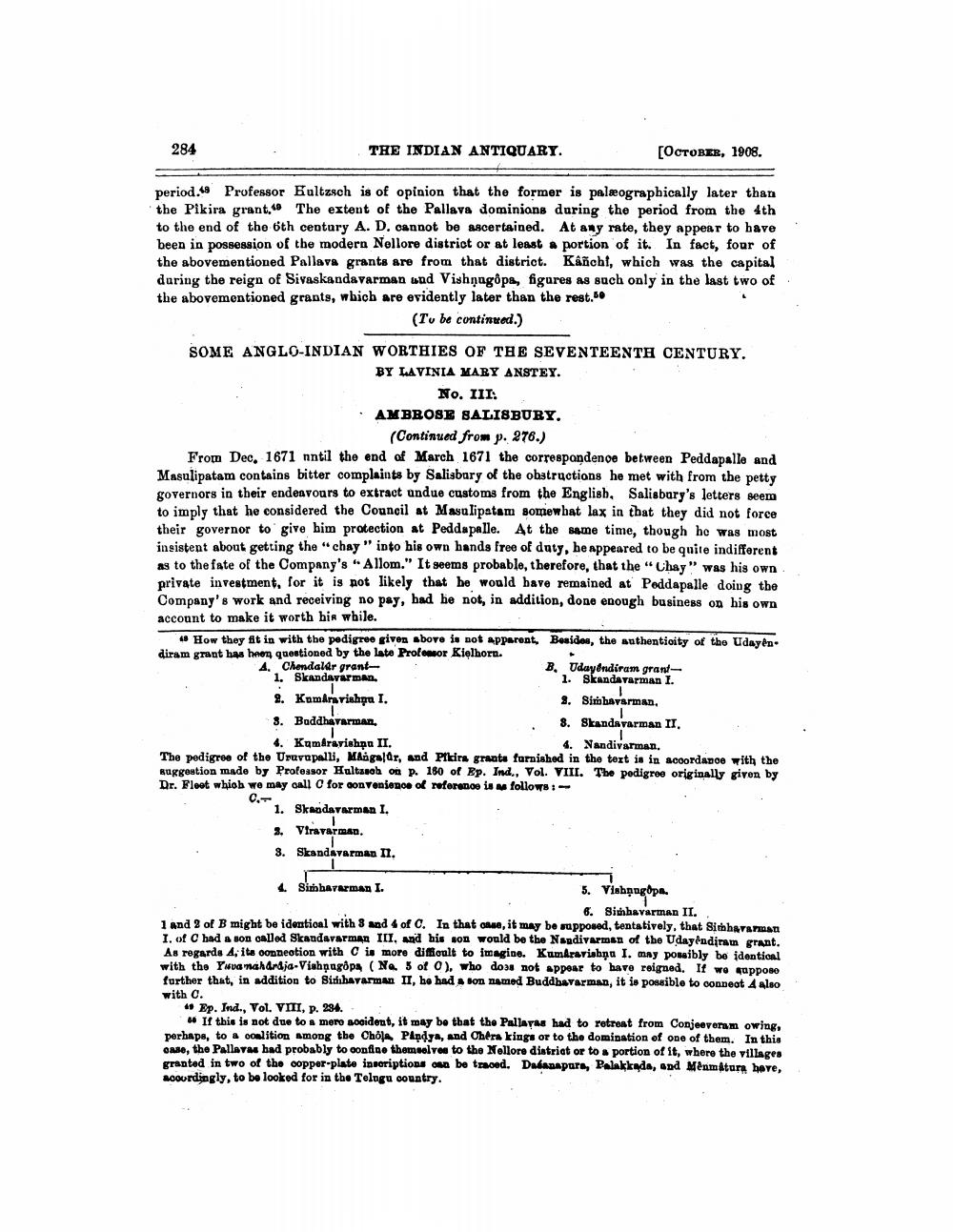________________
284
THE INDIAN ANTIQUARY.
[OCTOBER, 1908.
period. Professor Bultzsch is of opinion that the former is palæographically later than the Pikira grant. The extent of the Pallava dominions during the period from the 4th to the end of the 6th centary A. D. cannot be ascertained. At any rate, they appear to bave been in possession of the modern Nollore district or at least portion of it. In fact, four of the abovementioned Pallava grants are from that district. Káñcht, which was the capital during the reign of Sivaskandavarman und Vishmagopa, figures as such only in the last two of the abovementioned grants, which are evidently later than the rest.
(To be continued.)
SOME ANGLO-INDIAN WORTHIES OF THE SEVENTEENTH CENTURY.
BY LAVINIA MARY ANSTEY.
No. III: • AMBROSE SALISBURY,
(Continued from p. 276.) From Dec, 1671 nntil the end of March 1671 the correspondenge between Peddapalle and Masulipatam contains bitter complaints by Salisbury of the obstructions he met with from the petty governors in their endeavours to extract undue customs from the English, Salisbury's letters seem to imply that he considered the Council at Masa lipatam somewhat lax in that they did not force their governor to give him protection at Peddapalle. At the same time, though he was most insistent about getting the chay " into his own hands free of duty, he appeared to be quite indifferent as to the fate of the Company's - Allom." It seems probable, therefore, that the Chay" was his own private investment, for it is not likely that he would have remained at Peddapalle doing the Company's work and receiving no pay, bad be not, in addition, done enough business on his own account to make it worth his while.
How they fit in with the pedigree given above is not apparent. Besides, the authenticity of the Udaybno diram grant has hnen questioned by the late Profesor Kjelhorn. A. Chendaler grant
B, Uday&ndiram grant1. Skandavarman.
1. Skandavarman I. 2. Kamera rishpa I.
2. Simbavarmas 3. Baddhatarman,
8. Skandavarman II. 4. Kamerarishạn II.
4. Xandivarman. The pedigree of the Uruvapalli, Maigaldr, and Prins grants furnished in the text is in accordance with the suggestion made by Professor Hultanob on p. 180 of Ep. Ind., Vol. VIII. The pedigree originally given by Dr. Fleet whioh we may call C for convenience of reference is follows:
1. Skandavarman 1. 2. Viravarman. 3. Skandavarman II.
SimbaTaman I.
5. Yishạng
6. Sinhavarman II. 1 and 3 of B might be identical with 3 and 4 of C. In that case, it may be supposed, tentatively, that Sitharaman I. of Chad a son oalled Skandavarman III, and his son would be the Nandivarmen of the Udayandiran grant. As regards 4, its connection with C is more difficult to imagine. KumArarisbņa I. may possibly be identical with the Yuva nahardja-Vishnugopa (No. 5 of o), who do not appear to have reigned. If wowapporo further that, in addition to Sitibavarman II, he had son named Buddhavarman, it is possible to connect Also with 0. ** Ep. Ind., Vol. VIII, p. 284.
If this is not due to a mero accident, it may be that the Pallayas had to retreat from Conjeevoram owing, perhapa, to a coalition among the Chola Pandya, and Chera kings or to the domination of one of them. In this case, the Pallavus had probably to confloo themselves to the Nellore district or to a portion of it, where the villages granted in two of the copper plate inseriptions can be traced. Dabanapura, Palakkada, and Menmatura hove, nooordingly, to be looked for in the Telugu country.




